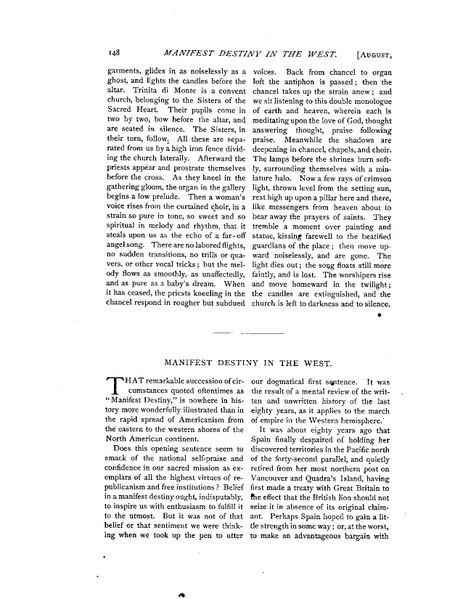USA: MANIFEST DESTINY
Manifest Destiny, a malign and sinister phrase first in common usage from around 1845, is the idea that the United States, (i.e. people without colour who had settled that land against the will of the original inhabitants) is destined—by God, or so its advocates and proponents believed—to expand its dominion and spread democracy and capitalism across the entire North American continent (and other parts of the world also occupied by peoples with colour). In short, the philosophy was one of White Supremacy. This philosophy drove 19th-century U.S. territorial expansion and was used to justify the forced removal of the First Peoples (also known as Native Americans) and other groups from their homes. The rapid expansion of the United States intensified the issue of slavery as new states were added to the Union, leading to the outbreak of the Civil War.
Louisiana Purchase
In 1776 came the Declaration of Independence of the 13 colonies on the Eastern coast of the landmass now known as the USA. The 13 states were; Massachusetts, New Hampshire, New York, Connecticut, Rhode Island, New Jersey, Delaware, Pennsylvania, Maryland, Virginia, North Carolina, South Carolina and Georgia.
Due to a rising birth rate and immigration, the US population increased dramatically in the first half of the 19th century, from around 5 million people in 1800 to more than 23 million by 1850.

This growth, as well as two economic depressions in 1819 and 1839 and incentives to move west in search of free land, sent millions of Americans sprawling westward in search of new land and new opportunities, no matter the cost to the original inhabitants and owners of that land.
President Thomas Jefferson kicked off the country’s westward expansion in 1803 with the Louisiana Purchase, which at some 828,000 square miles nearly doubled the size of the United States and stretched from the Mississippi River to the Rocky Mountains. In 1803, the French invaders sold a vast swathe of land to Jefferson for $15 million. The land had been the property and home of the First Peoples for centuries. With the westward expansion of the invading settlers from the 13 states that had declared independence from the English in 1776, came a sustained campaign of genocide and displacement against the First Peoples, in order to settle their ancestral land and make that land part of the expanding United States.
Jefferson also set his sights on Spanish Florida, a process that was finally concluded in 1819 under President James Monroe.
In 1823, Monroe invoked Manifest Destiny when he spoke before Congress to warn European nations not to interfere with America’s Westward expansion, threatening that any attempt by Europeans to colonize the “American continents” would be seen as an act of war. This policy of an American sphere of influence and of non-intervention in European affairs became known as the “Monroe Doctrine.” After 1870, it would be used as a rationale for U.S. interference and intervention in Latin America.

‘Manifest Destiny’
By the time Texas was admitted to the Union as a state in December 1845, having gained independence from Spain, the idea that the United States must inevitably expand westward all the way to the Pacific Ocean had taken firm hold among the people of the US.
The phrase “Manifest Destiny,” which emerged as the best-known expression of this mindset, first appeared in an editorial published in the July-August 1845 issue of The Democratic Review.
In it, the writer criticized the opposition that still lingered against the annexation of Texas, urging national unity on behalf of “the fulfillment of our manifest destiny to overspread the continent allotted by Providence for the free development of our yearly multiplying millions.”
As the phrase also appeared in a nearly identical context in a July 1845 article in the New York Morning News, its originator is believed to be John O’Sullivan, the editor of both the Democratic Review and the Morning News at the time. That December, another Morning News article mentioned “manifest destiny” in reference to the Oregon Territory, another new frontier over which the United States was eager to assert its dominion.
By the time the Oregon question was settled, the United States had entered into all-out war with Mexico, driven by the spirit of Manifest Destiny and territorial expansion.
The Treaty of Guadalupe Hidalgo, which ended the Mexican-American Warin 1848, added an additional 525,000 square miles of U.S. territory, including all or parts of what is now California, Arizona, Colorado, New Mexico, Nevada, Utah and Wyoming.
Despite the lofty idealism of Manifest Destiny, the rapid territorial expansion over the first half of the 19th century resulted not only in war with Mexico, but in the dislocation and brutal mistreatment of Native American, Hispanic and other non-European occupants of the territories now being occupied by the United States.
US expansion also fueled the growing debate over slavery, by raising the pressing question of whether new states being admitted to the Union would allow slavery or not, a conflict that would lead to the Civil War.
Once the US had settled every inch that we know as the USA today, they carried their lust for conquering to landscapes and places outside of their borders and succeeded in world, political and cultural domination.

In American Progress, a color print from about 1873, an allegorical female figure of America leads pioneers and railroads westward, in accordance with the concept of Manifest Destiny. The print was made after an 1872 painting by John Gast.




